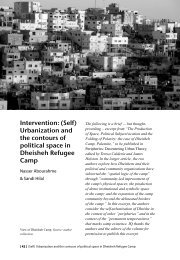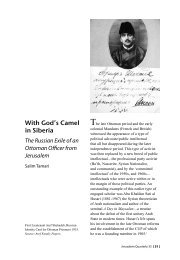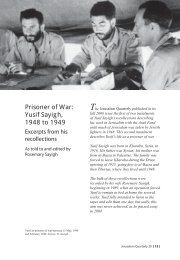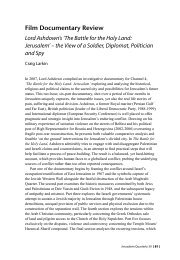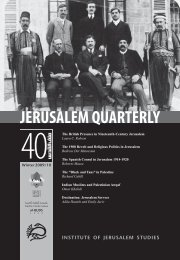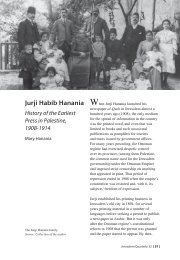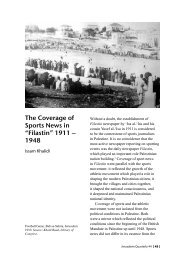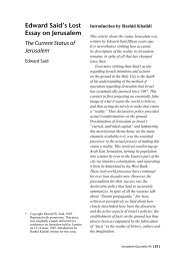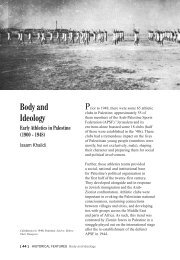Tawfik Canaan: His Life and Works* - Jerusalem Quarterly
Tawfik Canaan: His Life and Works* - Jerusalem Quarterly
Tawfik Canaan: His Life and Works* - Jerusalem Quarterly
Create successful ePaper yourself
Turn your PDF publications into a flip-book with our unique Google optimized e-Paper software.
<strong>Tawfik</strong> <strong>Canaan</strong>:<br />
<strong>His</strong> <strong>Life</strong> <strong>and</strong><br />
Works *<br />
Khaled Nashef<br />
<strong>Tawfik</strong> <strong>Canaan</strong> was a physician, an<br />
author, an advocate for the Palestinian<br />
cause, <strong>and</strong> a prominent scholar who is<br />
little known outside specialized circles. He<br />
graduated from medical school in 1905<br />
<strong>and</strong> immediately began a career in which<br />
he occupied medical <strong>and</strong> administrative<br />
positions in several <strong>Jerusalem</strong>-area<br />
hospitals <strong>and</strong> clinics until his retirement at<br />
age 75. <strong>Canaan</strong> was a prolific writer. In<br />
1914, at age 32, he published in German<br />
his first book, entitled Superstition <strong>and</strong><br />
Popular Medicine in the L<strong>and</strong> of the<br />
Bible. 1 He also authored more than 37<br />
12<br />
*<br />
Khaled Nashef is director of the Palestinian Institute<br />
of Archaeology at Birzeit University, Palestine. This<br />
article was translated from Arabic by Khalil Sleibi.<br />
1<br />
From here abbreviated as "Superstition <strong>and</strong> Popular<br />
Medicine." The present article is an abridged version of<br />
its counterpart in Arabic, published in Majallat<br />
ad-Dirasat al-Filastiniyya(h) 50 (Spring 2002), pp. 69-<br />
91. The reader is referred to the latter for extensive<br />
notes <strong>and</strong> bibliography, <strong>and</strong> to the electronic version of<br />
JQF.
medical studies in his field of<br />
specialization, tropical medicine; <strong>and</strong> in<br />
bacteriology, particularly malaria; <strong>and</strong> in<br />
other topics, such as leprosy, tuberculosis,<br />
<strong>and</strong> health in Palestine. In 1932, his name<br />
<strong>and</strong> a synopsis of his life were included in<br />
a book published in Germany under the<br />
title, "Famous Doctors in Tropical<br />
Medicine" by Dr. G. Olpp, who was the<br />
director of the well-known medical center<br />
for tropical medicine in the city of<br />
Tübingen.<br />
<strong>Canaan</strong> had interests outside the field of<br />
medicine. He was keenly interested in<br />
Palestinian folklore, popular beliefs, <strong>and</strong><br />
superstitions. He collected a prodigious<br />
number of amulets <strong>and</strong> produced more<br />
than 50 articles in English <strong>and</strong> German on<br />
folklore <strong>and</strong> superstition. Beyond that,<br />
<strong>Canaan</strong> wrote two books on the Palestine<br />
problem. They reflected his involvement<br />
in confronting British imperialism <strong>and</strong><br />
Zionism, <strong>and</strong> thus prompted the British<br />
Authorities to arrest him in 1939.<br />
Previous Biographies<br />
<strong>Tawfik</strong> <strong>Canaan</strong> lived the Palestinian<br />
tragedy since its beginning. As a<br />
distinguished physician in <strong>Jerusalem</strong><br />
before 1948, <strong>and</strong> later as the director of<br />
the Augusta Victoria Hospital, he enjoyed<br />
an eminent status in Palestinian society,<br />
particularly in <strong>Jerusalem</strong>. Given his<br />
stature, it is surprising that <strong>Canaan</strong>'s<br />
biographies were brief <strong>and</strong> in many cases<br />
limited. Before 1998, two biographical<br />
articles on <strong>Canaan</strong> were available. The<br />
first was written by the well-known<br />
biographer Ya'qub Al-'Awdat in 1971, <strong>and</strong><br />
the second was written by Yesma,<br />
<strong>Canaan</strong>'s daughter, in 1981, <strong>and</strong> was<br />
published in the journal Society <strong>and</strong><br />
Heritage (al-Bireh). A comparison<br />
between the two articles reveals<br />
conformity in much of the information.<br />
Neither biographer seems to have<br />
benefited from the obituary placed by<br />
Bishop Daud Haddad in 1964 or to have<br />
consulted what <strong>Canaan</strong> himself wrote.<br />
Furthermore, references to <strong>Canaan</strong> in<br />
sources outside the fields of medicine <strong>and</strong><br />
folklore were not considered. These are<br />
crucial omissions.<br />
More recently, the biographical<br />
information on <strong>Canaan</strong> was enriched. A<br />
catalog was published in Arabic <strong>and</strong><br />
English on the occasion of an exhibition<br />
organized by Birzeit University at the end<br />
of October 1998 under the title, Ya kafi, ya<br />
shafi ...The <strong>Tawfik</strong> <strong>Canaan</strong> Collection of<br />
Palestinian Amulets: An Exhibition.<br />
Unfortunately, this catalog was not widely<br />
distributed, <strong>and</strong> some of the information in<br />
it was brief <strong>and</strong> incomplete.<br />
This article aims to present a new <strong>and</strong><br />
thorough survey of <strong>Tawfik</strong> <strong>Canaan</strong>'s life<br />
that draws not only on information<br />
contained in primary sources, but also on<br />
inference from sources that are not<br />
directly related to <strong>Canaan</strong>, such as diaries<br />
<strong>and</strong> memoirs by Palestinian celebrities of<br />
the period.<br />
Childhood <strong>and</strong> Youth<br />
<strong>Tawfik</strong> <strong>Canaan</strong> was born in Beit Jala on<br />
September 24, 1882, the second child of<br />
Bechara <strong>Canaan</strong> <strong>and</strong> Katharina Khairallah.<br />
After completing his elementary school,<br />
<strong>Tawfik</strong>, like his father before him, was<br />
enrolled in Schneller School, where he<br />
completed his secondary education from<br />
the Teacher's Division (Seminar). In 1899,<br />
he went to Beirut to study medicine at the<br />
Syrian Protestant College (now known as<br />
the American University of Beirut).<br />
Shortly after he arrived in Beirut, his<br />
father died from pneumonia. This put him<br />
in a very difficult situation. The family<br />
13
which was later reflected in his writings<br />
such as the article entitled, "Plant-lore in<br />
Palestinian Superstition," published in<br />
1928. Faith <strong>and</strong> learning were givens in<br />
the <strong>Canaan</strong> household. The impact of the<br />
family <strong>and</strong> early upbringing remained<br />
strong in the children throughout their<br />
lives. <strong>Tawfik</strong> says, "At all stages in our<br />
lives, we the children carried a deep sense<br />
of the family blessing."<br />
<strong>Tawfik</strong> <strong>Canaan</strong> graduated with honors<br />
from the medicine school in 1905, <strong>and</strong> he<br />
delivered the graduation speech on June<br />
28, 1905. Entitled "Modern Treatment,"<br />
his speech was published in Al-Muqtataf -<br />
seemingly to have been his first published<br />
piece. In it, he touched on the medical use<br />
of serums, animal organs, <strong>and</strong> X-rays.<br />
<strong>Tawfik</strong> <strong>Canaan</strong> <strong>and</strong> Margot Eilender<br />
<strong>Jerusalem</strong> 1912<br />
Photo credit: Birzeit University Archive<br />
was poor <strong>and</strong> depended on the salary<br />
earned by his sister Lydia, a teacher, <strong>and</strong><br />
the pension his mother received for her<br />
deceased husb<strong>and</strong>. <strong>Tawfik</strong> started giving<br />
private lessons <strong>and</strong> doing other work at the<br />
university to supplement his income.<br />
Bechara left a strong impact on his son,<br />
but we do not know the mother's impact<br />
on him. <strong>Tawfik</strong> says the following about<br />
his father: "We used to go with my father<br />
on short <strong>and</strong> long trips all over the country<br />
in order to get acquainted with the country<br />
<strong>and</strong> the people. This continuous contact<br />
with the people nurtured in all of us, <strong>and</strong><br />
particularly in me, love for the country<br />
<strong>and</strong> the people. This feeling of belonging<br />
<strong>and</strong> unshaken loyalty remained with me<br />
till this day." 2 Maybe these trips explain<br />
his knowledge of nature in Palestine,<br />
The Beginning of <strong>Canaan</strong>'s<br />
Professional <strong>Life</strong><br />
Work had increased at the German<br />
Deaconesses Hospital (German Hospital)<br />
in <strong>Jerusalem</strong> in 1904, <strong>and</strong> there was a need<br />
to appoint an assistant doctor. The hospital<br />
offered <strong>Canaan</strong> the job before he<br />
graduated. He started his work in the<br />
summer of 1905 under the supervision of<br />
hospital director Dr. Grßendorf, a brilliant<br />
surgeon. <strong>Canaan</strong> notes in his diary:<br />
"Dr. Grußendorf was a skillful surgeon,<br />
<strong>and</strong> I learned a lot working under him. In<br />
order to gain as much scientific<br />
knowledge as possible, I worked a<br />
minimum of nine hours a day. Because of<br />
this, I could not open a private clinic<br />
during that period." 3 In 1906, Dr.<br />
Grußendorf went with some of the<br />
deaconesses on vacation <strong>and</strong> asked<br />
<strong>Canaan</strong>, together with Dr. Adolf Einszler,<br />
to assume the medical administration of<br />
the hospital as a shift physician.<br />
2<br />
Abdullah 1998, p. 17.<br />
3<br />
Schwake 1983, pp. 323-324.<br />
14
After <strong>Canaan</strong>'s appointment at the German<br />
Hospital, the hospital's capacity increased<br />
from 5,749 to 11,110 patients. And because<br />
physicians were scarce in <strong>Jerusalem</strong> at the<br />
outset of the twentieth century, it was<br />
common practice for physicians to seek the<br />
help of their colleagues to carry out specific<br />
duties or to act as hospital administrators in<br />
their absence. In 1906, Shaare Zedek<br />
Hospital (The German-Jewish Hospital)<br />
sought the help of <strong>Canaan</strong> as manager, most<br />
probably because Dr. Grußendorf was<br />
departing for Germany for a period of eight<br />
months. The hospital director, Dr. Moritz<br />
Wallach, was also in Germany to promote<br />
the newly established hospital. Yesma<br />
<strong>Canaan</strong> mentions that her father also<br />
worked for two periods of six months each<br />
at "The English Hospital" that belonged to<br />
the Anglican "London Jewish Society" for<br />
missionary work among Jews, but she does<br />
not give specific dates. It was no wonder<br />
that <strong>Canaan</strong> would, from time to time, work<br />
at the English Hospital, because its capacity<br />
increased remarkably between 1902 <strong>and</strong><br />
1912.<br />
<strong>Canaan</strong> the Researcher:<br />
The Beginnings<br />
In 1909, <strong>Canaan</strong>'s first long article was<br />
published in the geographical journal<br />
Globus. The article, entitled "Agriculture<br />
in Palestine," was a translation from<br />
Arabic into German of a lecture delivered<br />
by <strong>Canaan</strong> on May 22, 1909.<br />
Unfortunately, the occasion on which the<br />
lecture was delivered is not known, but the<br />
subject matter gives us an idea about the<br />
intellectual <strong>and</strong> political atmosphere that<br />
prevailed in Palestine on the eve of the<br />
collapse of the Ottoman Empire. The basic<br />
idea of the article is that Palestine (by<br />
which <strong>Canaan</strong> meant the West <strong>and</strong> East<br />
Bank of Jordan, <strong>and</strong> includes the Golan,<br />
'Ajloun, Houran, <strong>and</strong> Al-Balqa), which<br />
witnessed a deterioration <strong>and</strong> negligence<br />
in agriculture starting from the Ayyubid<br />
Period, <strong>and</strong> particularly during the<br />
Ottoman period, was doing much better in<br />
recent times. It is obvious from reading<br />
the article that <strong>Canaan</strong> (<strong>and</strong> with him,<br />
most probably, the original audience) was<br />
concerned about the poor state of the<br />
Palestinian peasants after centuries of<br />
exploitation <strong>and</strong> negligence. This<br />
negligence led to the deterioration of the<br />
agricultural l<strong>and</strong> <strong>and</strong> terraces, despite the<br />
fertility of the l<strong>and</strong> <strong>and</strong> its potential for<br />
exploitation if modern means had been<br />
used within the framework of a<br />
comprehensive economic policy.<br />
<strong>Canaan</strong>'s ideas on agricultural potential<br />
were influenced by experiments<br />
performed in Palestine, particularly by the<br />
German (Templar) colonies. <strong>Canaan</strong> urged<br />
Palestinians to learn from their<br />
experiments <strong>and</strong> also to imitate Jewish<br />
colonies (even though he also took a<br />
negative attitude toward them, describing<br />
them as "wholly depending on the<br />
contributions of wealthy Jews"). 4<br />
Despite the article's shortcomings, it<br />
remains a basic reference on the<br />
development of agriculture in Palestine<br />
<strong>and</strong> a good diagnosis of its condition. In<br />
this first article outside the field of<br />
medicine, <strong>Canaan</strong> establishes himself as a<br />
well-versed researcher in the field of socalled<br />
"Oriental Studies." It is noticeable<br />
that he quotes not only the familiar names<br />
of his age, such as Schumacher, Bauer,<br />
Guthe, Burckhardt, <strong>and</strong> others, but also<br />
classical sources, such as Strabo <strong>and</strong><br />
Josephus, as well as Arab sources like<br />
Mujeer ad-Din. The article demonstrates<br />
<strong>Canaan</strong>'s interest in the future of his<br />
4<br />
<strong>Canaan</strong> 1909, p. 286.<br />
15
country by studying the conditions of<br />
peasants, who were at that time the<br />
productive force in Palestine. <strong>His</strong> interest<br />
in the peasants may have led him to study<br />
superstitions prevailing in the countryside,<br />
<strong>and</strong> particularly the use of amulets.<br />
The Bible<br />
The Bible, particularly the Old<br />
Testament, is one of the basic sources that<br />
<strong>Canaan</strong> depended on in his comparison of<br />
past <strong>and</strong> present agriculture. Studies of the<br />
Old Testament were proceeding quickly<br />
during <strong>Canaan</strong>'s time, <strong>and</strong> he knew the<br />
leaders of these studies, such as Gustaf<br />
Dalman, Albrecht Alt, <strong>and</strong> Martin Noth.<br />
<strong>Canaan</strong> used the four years that separated<br />
his graduation <strong>and</strong> the date he published<br />
his first article to absorb the contemporary<br />
trends in biblical studies, <strong>and</strong> the Old<br />
Testament in particular. We cannot<br />
attribute <strong>Canaan</strong>'s focus on the Bible<br />
solely to his religious background. We<br />
must assume that Dalman, who headed<br />
"The Evangelical German Institute" since<br />
1903, had influenced <strong>Canaan</strong>, especially<br />
considering that the two apparently shared<br />
the idea that it is not possible to<br />
underst<strong>and</strong> the Old Testament without<br />
studying Palestinian folklore.<br />
Specialization<br />
In the summer of 1910, <strong>Canaan</strong> was put<br />
in charge of a polyclinic for the<br />
Municipality of <strong>Jerusalem</strong> <strong>and</strong> remained<br />
there until the clinic merged in 1912 with<br />
a municipal hospital established in the<br />
Shaykh Badr area. In 1911, he published<br />
his first basic medical article, entitle<br />
"Cerebro-Spinal Meningitis in <strong>Jerusalem</strong>,"<br />
in Al-Kulliyeh (Beirut) journal. In it, he<br />
pointed out that he was conducting<br />
detailed studies with Dr. Wallach, director<br />
of Shaare Zedek Hospital, who provided<br />
him with the necessary statistics from the<br />
hospital.<br />
In 1912 <strong>and</strong> 1913, <strong>and</strong> during the first<br />
four months of 1914, <strong>Canaan</strong> specialized<br />
in tropical medicine <strong>and</strong> microbiology in<br />
Germany under Professors Mühlens,<br />
Ruge, Much, <strong>and</strong> Huntemüler. Mühlens<br />
was chief marine physician at an institute<br />
in Hamburg for ship <strong>and</strong> tropical diseases,<br />
particularly malaria, <strong>and</strong> was the founder<br />
of the International Health Bureau.<br />
<strong>Canaan</strong> likened this Bureau to the French<br />
Pasteur Institute. Mühlens headed the<br />
famous Malaria Mission to <strong>Jerusalem</strong> <strong>and</strong><br />
prepared a report that gave a<br />
comprehensive description of the health<br />
conditions in <strong>Jerusalem</strong> on the eve of<br />
World War I. According to Leila<br />
Mantoura, <strong>Canaan</strong>'s daughter, <strong>Canaan</strong> was<br />
Mühlens' assistant in this mission. From<br />
this we can conclude that <strong>Canaan</strong><br />
specialized in tropical medicine in<br />
Hamburg, <strong>and</strong> while he was there he may<br />
have contacted the publishing house L.<br />
Friederichsen & Co., which specialized in<br />
publishing studies on the third world, to<br />
publish his book Superstition <strong>and</strong> Popular<br />
Medicine. <strong>Canaan</strong> studied tuberculosis<br />
with Hans Much, who also headed a<br />
mission to Palestine to study tuberculosis<br />
<strong>and</strong> published the results in 1913. <strong>Canaan</strong><br />
contributed three research papers to this<br />
report.<br />
Palestinian Folklore<br />
In 1913, the Zeitschrift des Deutschen<br />
Palästinavereins (Journal of the German<br />
Palestine Society) published an article by<br />
<strong>Canaan</strong> entitled "The Calendar of Palestinian<br />
Peasants," which was his first work in the<br />
field of Palestinian folklore. In 1914, he<br />
published his first book, Superstition <strong>and</strong><br />
Popular Medicine. Over the next thirteen<br />
years, he published a number of articles in<br />
16
The Journal of the Palestine Oriental<br />
Society, established in 1920 by Albert T.<br />
Clay, the American Assyriologist. <strong>Canaan</strong><br />
was chosen as a member in that Society. He<br />
was also a member in The American School<br />
for Oriental Research, which was<br />
established in 1900 <strong>and</strong> whose <strong>Jerusalem</strong><br />
branch was headed from 1920 till 1929 by<br />
the American archaeologist William Foxwell<br />
Albright. In the articles that <strong>Canaan</strong><br />
published during this period, he showed a<br />
special interest in superstition; examples<br />
include "Haunted Springs <strong>and</strong> Water<br />
Demons in Palestine" (1920/1921), "Tasit<br />
ar-Radjfeh" (Fear Cup; 1923),<br />
"Mohammedan Saints <strong>and</strong> Sanctuaries in<br />
Palestine" (1924-1927), <strong>and</strong> "Plant-lore in<br />
Palestinian Superstition" (1928).<br />
Popular Beliefs<br />
<strong>Canaan</strong>'s interest in popular beliefs<br />
focused on the spiritual beliefs as they<br />
relate to daily practices, primarily among<br />
peasants, <strong>and</strong> not on the practices as such,<br />
as was the case with other researchers,<br />
such as Bauer, Dalman, <strong>and</strong> Granqvist.<br />
<strong>Canaan</strong> specifically focused on the<br />
superstition of the peasants <strong>and</strong> lower<br />
classes in cities. Popular beliefs often have<br />
roots in folkloric substrates from various<br />
periods, some of which predate<br />
monotheism, <strong>and</strong> are somehow related to<br />
magic. The article entitled "Mohammedan<br />
Saints <strong>and</strong> Sanctuaries in Palestine,"<br />
which was also published as a monograph,<br />
became a classic in the field of Palestinian<br />
folklore. The sanctuary (maqam) is the<br />
material expression of popular beliefs. The<br />
phenomenon of maqamat is perhaps the<br />
best source of information about<br />
ideological trends among Palestinian<br />
peasants. Contrary to monotheism, which<br />
is especially espoused in cities, <strong>and</strong> contrary<br />
to written history, also produced in cities, the<br />
spiritual systems related to sanctuaries are<br />
reflections of previous conditions or a<br />
reproduction of it, including historical<br />
elements that are embodied in the sanctuary<br />
<strong>and</strong> its weli or shaykh. The sanctuary of<br />
Shaykh al-Qatrawani in 'Atarah village,<br />
north of Ramallah, for example, is a<br />
personification of an earlier figure, namely,<br />
Saint Catherine, to whom a church was<br />
dedicated in the area surrounding the<br />
sanctuary (the example is <strong>Canaan</strong>'s). The<br />
Shaykh, according to the popular tale, came<br />
flying from a distant place (Gaza) <strong>and</strong> settled<br />
in 'Atarah. The tradition seems to reflect an<br />
attempt to absorb a Christian religious<br />
personality within the Islamic system.<br />
Demonology<br />
If sanctuaries are the material expression<br />
of popular beliefs, the place of performing<br />
relevant rituals, <strong>and</strong> what confers<br />
protection <strong>and</strong> blessings on the villages,<br />
then this must be because the supernatural<br />
forces are found everywhere, affect the<br />
course of life, <strong>and</strong> bring good or bad luck,<br />
particularly diseases. This was the topic of<br />
<strong>Canaan</strong>'s book, "Belief in Demons in the<br />
Holy L<strong>and</strong>" (1929, in German). In it,<br />
<strong>Canaan</strong> discusses the life of demons, their<br />
names, <strong>and</strong> areas of their effect. <strong>His</strong><br />
perception of demons was the traditional<br />
one, namely, that they were originally<br />
deities within the polytheistic system, or<br />
within the framework of what <strong>Canaan</strong><br />
called "primitive religions." With the<br />
advent of monotheism, the status of these<br />
gods, good or bad, was downgraded, but<br />
they subsisted in the unconscious of the<br />
community as demons. <strong>Canaan</strong> gathered<br />
in his book every reference to demons in<br />
Palestinian popular beliefs. He detailed their<br />
food, dress, appearance, <strong>and</strong> dwellings<br />
(terrestrial spirits <strong>and</strong> "hell" spirits), such as<br />
the carob tree. <strong>Canaan</strong> also gathered a long<br />
17
list of demon names <strong>and</strong> their classes. It<br />
should be noted that the names of some<br />
diseases refer to names of long-forgotten<br />
demons, such as al-khanuq (diphteria),<br />
ar-rih al-asfar (cholera), <strong>and</strong> at-ta'un<br />
(plague).<br />
Superstition<br />
It is not known when <strong>Canaan</strong> developed<br />
his interest in superstition, which he<br />
singled out from the components of<br />
Palestinian folklore. But it is possible to<br />
say that <strong>Canaan</strong>'s interest in superstition,<br />
particularly amulets, had started when he<br />
returned after completing his studies <strong>and</strong><br />
began his professional life. Leila<br />
Mantoura, <strong>Canaan</strong>'s daughter, says: "It<br />
was through the polyclinic [of the<br />
<strong>Jerusalem</strong> Municipality] <strong>and</strong> his visits to<br />
outlying villages <strong>and</strong> hamlets, on<br />
horseback, carrying a bag full of<br />
medicines, that he noticed many women<br />
<strong>and</strong> men wearing amulets. After treating<br />
them, he would discuss with the patients<br />
what protection these amulets offered, ...<br />
He often bought the amulets, or took them<br />
in lieu of payment for his treatment." 5<br />
Later on, peasants would bring amulets to<br />
<strong>Canaan</strong>'s house, <strong>and</strong> when he had no<br />
opportunity to go around in the country, he<br />
used to buy the pieces from antique<br />
dealers.<br />
<strong>His</strong> first article on superstition, "Demons<br />
as an Aetiological Factor in Popular<br />
Medicine," was published in 1912 in Al-<br />
Kulliyeh (Beirut) <strong>and</strong> was a translation<br />
from German into English of part of his<br />
book Superstition <strong>and</strong> Popular Medicine<br />
(published in 1914). Accordingly, the<br />
starting point for investigating the<br />
particularity of <strong>Canaan</strong>'s thought would be<br />
1912 with a focus on the above book <strong>and</strong><br />
not on <strong>Canaan</strong>'s article, "The Calendar of<br />
Palestinian Peasants," which was<br />
published in 1913.<br />
<strong>Canaan</strong> could not have completed the<br />
research for his book Superstition <strong>and</strong><br />
Popular Medicine without a long process<br />
lasting years during which he gathered an<br />
extensive collection of amulets. In his<br />
1912 article, <strong>Canaan</strong> wrote, "I have<br />
occupied myself during the past year with<br />
the subject 'Popular Palestinian Medicine'<br />
<strong>and</strong> have gathered a large number of<br />
amulets that are used in curative <strong>and</strong><br />
preventive ways. It is certainly not<br />
sufficient merely to possess such a<br />
collection <strong>and</strong> to know superficially what<br />
each object means; therefore, I have<br />
endeavored to find how <strong>and</strong> where they<br />
were made, how they are used in the<br />
different parts of the country <strong>and</strong> for what<br />
ailments, how they act, etc." 6 Leila<br />
Mantoura stated that her father started<br />
collecting amulets in 1905. One can<br />
therefore surmise that his ideas on this<br />
topic matured between 1910 <strong>and</strong> 1912.<br />
Superstition is reflected in the use of<br />
amulets, including charms <strong>and</strong> talismans.<br />
The importance of <strong>Canaan</strong>'s studies in this<br />
field derives from the fact that he was the<br />
first to study the amulets within their<br />
context in the culture of Palestinian<br />
peasants <strong>and</strong> Bedouin, <strong>and</strong> by an Arab<br />
who was able to underst<strong>and</strong> their<br />
connotations to the people who used them.<br />
The language of these amulets is<br />
expressed in words, gestures, <strong>and</strong><br />
drawings. In the foreword of Superstition<br />
<strong>and</strong> Popular Medicine, <strong>Canaan</strong> wrote:<br />
"How many issues in superstition cannot<br />
be uttered or hinted at except through<br />
strange words that seem to reach the realm<br />
of the intangible. The word should be<br />
5<br />
Mantoura 1998b, p. 9.<br />
6<br />
<strong>Canaan</strong> 1912, p. 150.<br />
18
eplaced by drawings, pictures, signs, <strong>and</strong><br />
conduct because uttering the word exposes<br />
healing through superstition to failure.<br />
Thus, we enter a world of interrelated<br />
superstitious symbols which overwhelm<br />
the entire oriental life." 7<br />
The difficulty encountered by the<br />
researcher <strong>and</strong> by <strong>Canaan</strong> in this field has<br />
to do with an esoteric knowledge<br />
possessed <strong>and</strong> protected by a minority of<br />
specialized persons, such as sheikhs <strong>and</strong><br />
fortune-tellers, whose positions are similar<br />
to that of shamans. Some sheikhs have<br />
published books that deal with various<br />
aspects of this knowledge, such as Shumus<br />
al-Anwar by Ibn al-Haj at-Talsamani, <strong>and</strong><br />
Shams al-Ma'arif al-Kubra by al-Bouni,<br />
two sources that <strong>Canaan</strong> drew on in<br />
writing his book. He also consulted a<br />
manuscript at Al-Khalidiyyah Library in<br />
<strong>Jerusalem</strong> that contains explanations of<br />
talismans. These books, however, were<br />
mostly a collection of remarks <strong>and</strong><br />
instructions, which their authors used as<br />
manuals in their profession <strong>and</strong> were not<br />
meant as analysis or interpretation.<br />
<strong>Canaan</strong> made use of various historical<br />
sources <strong>and</strong> the information gained from<br />
sheikhs <strong>and</strong> from the patients themselves<br />
to formulate his own interpretations.<br />
The phrase "popular medicine" in the<br />
title of the book does not refer to inherited<br />
popular practices for the treatment of<br />
somatic diseases, or to the use of (plant or<br />
other) natural extracts, as it might seem at<br />
first glance. <strong>Canaan</strong> rarely touched on this<br />
form of treatment or the materials used in<br />
it. Nor did he take up fortune telling,<br />
performed by the sheikhs or fortune-tellers,<br />
in his writings in general. Instead, he<br />
compared what he called "popular medicine"<br />
with medicine in the scientific meaning of the<br />
7<br />
<strong>Canaan</strong> 1914, p. VIII.<br />
word <strong>and</strong> its related branches. The former<br />
relates the stages of the disease to<br />
superstition, or supernatural forces, <strong>and</strong><br />
attributes remission to magical practices.<br />
Accordingly, <strong>Canaan</strong>, the "scientific"<br />
physician, classifies amulets under the<br />
subheadings etiology, diagnosis, prognosis,<br />
prophylaxis, <strong>and</strong> treatment <strong>and</strong> divides the<br />
chapters of his book accordingly. Under the<br />
subheading "Etiology" come evil spirits, such<br />
as the Qarinah, "Mother of Boys," <strong>and</strong> evil<br />
eye; <strong>and</strong> under the subheading "Prophylaxis"<br />
come charms, amulets, <strong>and</strong> special types of<br />
beads, such as the blue bead, eyes, alum,<br />
<strong>and</strong> finally the mes-branch taken from the<br />
mes-tree (celtis australis) that grows within<br />
the precinct of al-Haram in <strong>Jerusalem</strong>. The<br />
branch is put in a necklace or on the head<br />
<strong>and</strong> has a special effect if harvested on<br />
Laylat al-Qadr (27 Ramadan), the night<br />
when Muslims believe the Quran was<br />
revealed. Under the "Treatment" subheading<br />
are listed amulets <strong>and</strong> all kinds of talismans.<br />
In this chapter, <strong>Canaan</strong> touches on the topic<br />
of jewelry, which has the effect of amulets,<br />
<strong>and</strong> on special kinds of amulets, such as "the<br />
soul's bead," "the cat's eye," "the milk's<br />
bead." (for the flow of milk), <strong>and</strong> others.<br />
He also touches on special parts of<br />
animals, such as the al-hitit-horn (against<br />
poisoning).<br />
Marriage <strong>and</strong> the Home<br />
In January 1912, <strong>Canaan</strong> married Margot<br />
Eilender, the daughter of a German<br />
importer, <strong>and</strong> the wedding gift was a piece<br />
of l<strong>and</strong> in al-Musrarah where, in 1913,<br />
they built a house. Three of <strong>Canaan</strong>'s<br />
children (Theo, Nada, <strong>and</strong> Leila) were born<br />
in this house. In the new family house,<br />
<strong>Canaan</strong> opened a clinic, the only Arab clinic<br />
in <strong>Jerusalem</strong>. The house fell in the "no man's<br />
l<strong>and</strong>" between the years 1948 <strong>and</strong> 1967,<br />
<strong>and</strong> it is still there to this day.<br />
19
World War I<br />
In 1913, <strong>Canaan</strong> was appointed director<br />
of the Malaria Branch of the International<br />
Health Bureau, which was a world center<br />
for conducting medical research <strong>and</strong><br />
microscopic examination established by<br />
The German Society for Fighting Malaria,<br />
The Jewish Health Bureau, <strong>and</strong> The<br />
Jewish Physicians <strong>and</strong> Scientists for<br />
Improving Health in Palestine.<br />
After spending four months in Germany,<br />
<strong>Canaan</strong> returned to Palestine in August<br />
1914 to work in the German Hospital with<br />
Grußendorf. He might have stayed in this<br />
position but for the coming of October<br />
when the Ottoman Empire actually entered<br />
World War I. Since he held the Ottoman<br />
nationality, he was forced to join the<br />
Ottoman army <strong>and</strong> to work under difficult<br />
conditions. Like many officers at that<br />
time, he contracted cholera <strong>and</strong> typhoid.<br />
At the beginning, he was the physician for<br />
a contingent in Nazareth, but in the same<br />
year he was transferred to 'Awja al-Hafeer,<br />
where the German chief physician<br />
appointed him as Head of the Laboratories<br />
on the Sinai Front. In this capacity, he was<br />
able to move between Beer as-Sab', Beit<br />
Hanoun, Gaza, <strong>and</strong> Shaykh Nouran.<br />
<strong>Canaan</strong> took advantage of this movement<br />
between cities, including Damascus,<br />
Amman, <strong>and</strong> Aleppo, <strong>and</strong> collected more<br />
than two hundred amulets.<br />
The Leprosy Hospital<br />
At the end of the war, <strong>Canaan</strong> resumed<br />
his professional activity <strong>and</strong>, in 1919, he<br />
became director of the Leprosy Hospital<br />
(Asylum of the Lepers) in Talbiyyah,<br />
which used to be called Jesushilfe,<br />
following the death of its director, Dr.<br />
Einszler. 8 It was also the only leprosy<br />
hospital in Syria, Palestine, <strong>and</strong><br />
Transjordan. Leprosy was considered an<br />
incurable disease; however, the progress in<br />
the field of bacteriology <strong>and</strong> microscopic<br />
examination, in which <strong>Canaan</strong> himself<br />
participated, made it possible not only to<br />
treat that disease, but to cure it by using<br />
chaulmoogra oil. <strong>Canaan</strong> said that since<br />
1921, "Every case which had some hope<br />
of recovery, regardless of how small, was<br />
treated with determination at the Leprosy<br />
Hospital." 9<br />
In 1923, the German Hospital was<br />
reopened with a capacity of fifty patients,<br />
but actual medical work could not be<br />
started until the following year because it<br />
needed further renovations. The Hospital<br />
consisted of three divisions: Internal<br />
Medicine, Gynecology, <strong>and</strong> Surgery.<br />
<strong>Canaan</strong> was in charge of the Internal<br />
Medicine Division, where he remained<br />
until 1940, when it became difficult for the<br />
German Hospital to continue to operate.<br />
German citizens had already left Palestine<br />
by 1939, including his friend Eberhard<br />
Gmelin (who headed the Surgery Division<br />
of the hospital), or were arrested by the<br />
British Authorities.<br />
Political Struggle<br />
The British authorities arrested <strong>Canaan</strong><br />
on September 3, 1939, the very day that<br />
Britain <strong>and</strong> France declared war on<br />
Germany. He appeared twice in court <strong>and</strong><br />
was ordered released, but the so-called The<br />
Criminal Investigation Department objected<br />
<strong>and</strong> he was imprisoned for nine weeks in<br />
Akka. <strong>His</strong> wife was arrested because she<br />
was German, <strong>and</strong> so was his sister Badra,<br />
who was accused "of inciting Arab women<br />
against Britain." 10 <strong>His</strong> wife <strong>and</strong> sister were<br />
8<br />
In many cases, <strong>Canaan</strong>'s time at different hospitals<br />
overlapped.<br />
9<br />
<strong>Canaan</strong> 1926, p. 46.<br />
20
imprisoned in the women's prison in<br />
Bethlehem with Jewish criminal prisoners,<br />
the first for nine months, <strong>and</strong> the second for<br />
four years. When their periods of detention<br />
ended, they were sent to Wilhelma,<br />
southwest al-'Abbasiyyah (near Jaffa), one<br />
of the German colonies that were<br />
transformed into detention camps for<br />
German Palestinians.<br />
<strong>Canaan</strong>'s wife <strong>and</strong> sister Badra had been<br />
politically active since the beginning of<br />
the revolt in 1936. Leila Mantoura wrote:<br />
"In 1934, my mother <strong>and</strong> aunt Badra were<br />
among those who founded the Arab<br />
Women's Committee in <strong>Jerusalem</strong>. This<br />
was a charitable society at the outset, but<br />
soon took on a political nature in the year<br />
1936 during the general strike." 11 In fact,<br />
the Arab Women's Committee was<br />
involved in political activity prior to 1936,<br />
at least since the establishment of<br />
committees in <strong>Jerusalem</strong> <strong>and</strong> other cities,<br />
following the convening of a general<br />
conference for Palestinian women in<br />
October 1929. By May 1936, the<br />
Committee was strong enough to publicly<br />
call for civil disobedience <strong>and</strong><br />
continuation of the strike. Badra<br />
participated as assistant secretary in the<br />
Palestinian delegation to The Eastern<br />
Women's Conference that was held in<br />
Cairo in mid-October 1938 in support of<br />
Palestine.<br />
Ya'qub Al-'Awdat claims that <strong>Canaan</strong>,<br />
his wife, <strong>and</strong> his sister were accused of<br />
"propag<strong>and</strong>a for Hitler's Germany." 12 It is<br />
not known whether this was the official<br />
charge, nor do we know the type of court<br />
in which they were tried. This was part of<br />
the British policy for eliminating what was<br />
left of the Palestinian resistance movement<br />
10<br />
Mantoura 1998a.<br />
11<br />
Mantoura 1998b, p. 12.<br />
<strong>and</strong> its symbols under the pretext of the war.<br />
Since the beginning of the 1936 revolt,<br />
<strong>Canaan</strong> clearly expressed his rejection of<br />
British <strong>and</strong> Zionist policies, in particular the<br />
policy of open-door Jewish immigration to<br />
Palestine. He opposed Zionism whenever<br />
possible, as was shown in his response to an<br />
article that appeared in one of the German<br />
medical periodicals in 1925, in which the<br />
writer commented on Jewish health<br />
establishments <strong>and</strong> on Zionism <strong>and</strong> touched<br />
briefly on Palestinian establishments. <strong>Canaan</strong><br />
published his response in the same<br />
periodical. He pursued this approach even<br />
after 1948. In 1949, he wrote a short<br />
article to refute the claims of an official<br />
U.S. report "that the death rate among the<br />
[Palestinian] refugees is running no higher<br />
than normal for the Near East." 13<br />
The Palestine Arab Cause<br />
<strong>Canaan</strong>'s political position was clearly<br />
expressed in two works of his, namely,<br />
The Palestine Arab Cause <strong>and</strong> Conflict in<br />
the L<strong>and</strong> of Peace, both written in 1936.<br />
The former was published in English,<br />
Arabic, <strong>and</strong> French. The 48-page booklet<br />
The Palestine Arab Cause, originally<br />
written in English, resembled a political<br />
pamphlet directed at British public<br />
opinion. It was originally published in the<br />
form of articles in the local <strong>and</strong> foreign<br />
press shortly after the outbreak of the<br />
general strike in 1936. For the British<br />
M<strong>and</strong>ate, <strong>Canaan</strong>'s writing was considered<br />
subversive. <strong>Canaan</strong> questioned whether<br />
the British policy was intended "to force<br />
Palestinian Arabs to evacuate their whole<br />
l<strong>and</strong> in order to make room for Jews." 14 He<br />
went further by describing the policy as "a<br />
destructive campaign against the Arabs with<br />
12<br />
Al-'Awdat 1971, p. 32.<br />
13<br />
<strong>Canaan</strong> 1949, p. 33.<br />
21
the ultimate aim of exterminating them from<br />
their country." <strong>Canaan</strong> also questioned the<br />
nationality laws enacted by the M<strong>and</strong>ate that<br />
prevented Palestinian immigrants in the<br />
Americas, who were at that time citizens of<br />
the Ottoman Empire, from obtaining<br />
Palestinian citizenship.<br />
The Palestine Arab Cause concludes<br />
with these words: "We appeal to the sense<br />
of justice of every Britisher to help us in<br />
our fight for existence..." 15 <strong>Canaan</strong><br />
asserted: "We will continue our struggle<br />
for life in peaceful ways until we attain,<br />
with God's help, a better life, or we die<br />
never to rise again," in case there was no<br />
response to the basic dem<strong>and</strong> of the<br />
Palestinian Arabs, namely, an immediate<br />
<strong>and</strong> complete halt to Zionist immigration.<br />
<strong>Canaan</strong> had a clear, uncompromising, <strong>and</strong><br />
unreconciliatory position concerning<br />
national dem<strong>and</strong>s, as shown in a document<br />
sent to the Higher Arab Committee on<br />
August 6, 1936 <strong>and</strong> signed by <strong>Canaan</strong>, as<br />
well as many national personalities. There<br />
is even an unconfirmed evidence that<br />
<strong>Canaan</strong> strongly supported providing Arab<br />
rebels with arms. <strong>Canaan</strong>'s approach in<br />
this booklet reflects an appraisal of the<br />
Palestinian problem from a clear national<br />
perspective, notwithst<strong>and</strong>ing the<br />
apologetic language he sometimes used<br />
towards Britain that might seem<br />
inappropriate from a modern perspective.<br />
Conflict in the L<strong>and</strong> of Peace<br />
In his book, Conflict in the L<strong>and</strong> of<br />
Peace, <strong>Canaan</strong> documents the Palestinian<br />
problem in greater detail <strong>and</strong> responds to<br />
those who criticized The Palestine Arab<br />
Cause, particularly the "comments" by an<br />
anonymous person published in a pamphlet,<br />
14<br />
<strong>Canaan</strong> 1936a, p. 10.<br />
15<br />
<strong>Canaan</strong> 1936a, p. 21.<br />
which enumerated the "benefits" that the<br />
inhabitants of Palestine derived from the<br />
Jewish immigrants. <strong>Canaan</strong> refuted the<br />
presumed benefits, such as the availability of<br />
scientists at the Hebrew University <strong>and</strong><br />
hospitals, the funds that were brought into<br />
Palestine (for example, through l<strong>and</strong><br />
purchases, of all things!), the improvement in<br />
agriculture, the rise in the average wages of<br />
the Palestinian worker, <strong>and</strong> the improvement<br />
in the health conditions among peasants.<br />
With respect to the last point, <strong>Canaan</strong>, who<br />
was well-versed on the subject, did not<br />
deny that the Jews had dried out some of<br />
the swamps <strong>and</strong> streams here <strong>and</strong> there,<br />
<strong>and</strong> thus contributed to the control of the<br />
widespread malaria epidemic. However,<br />
these preventive measures were<br />
undertaken, primarily, for the benefit of<br />
the Jewish colonists themselves, <strong>and</strong> for<br />
transforming l<strong>and</strong> bought at a very low<br />
price into agricultural l<strong>and</strong>. <strong>Canaan</strong> also<br />
pointed out that the Jews employed<br />
Egyptian laborers for digging wide<br />
channels necessary for the drying out<br />
process <strong>and</strong> that tens of these laborers<br />
died, as was documented in a booklet<br />
entitled Hadera. He wrote, "Baron De<br />
Rothschild supplied the money <strong>and</strong> the<br />
Egyptians gave their lives." 16<br />
<strong>Canaan</strong> also stated what the Zionists did<br />
not, namely, that the Palestinians too had<br />
dried out the swamps under the<br />
supervision of the Department of Health<br />
<strong>and</strong> that their achievement in this respect<br />
was, undoubtedly, greater than that of the<br />
Jews. The Arabs had provided financial<br />
support <strong>and</strong> unpaid labor in the following<br />
areas: Birkat Ramadan, Wadi Rubeen,<br />
Wadi al-Qabbani, Al-Lajjoon, Nahr an-<br />
Na'ameen, At-Tanturah, Deir al-Balah, <strong>and</strong><br />
tens of other valleys throughout Palestine.<br />
16<br />
<strong>Canaan</strong> 1936b, p. 87.<br />
22
Finally, <strong>Canaan</strong> stated that the work done<br />
by the Jewish Hydro-Electric Co. of<br />
Rutenberg brought down the level of water<br />
at Lake Tiberias, which led to the spread<br />
of malaria. He cited two reports issued by<br />
the Department of Health for the years<br />
1924 <strong>and</strong> 1935 to the effect that the<br />
increase in the malaria cases around<br />
Tiberias was the direct result of the low<br />
level of the lake, which provided an ideal<br />
environment for the growth of the malaria<br />
microbe. There had always been cases of<br />
malaria infection among the Bedouins <strong>and</strong><br />
in the Arab villages around Tiberias, such<br />
as Tall Hom, At-Tabighah, Al-Majdal, <strong>and</strong><br />
Tiberias.<br />
The Arab Medical Society of Palestine<br />
The Arab Medical Society of Palestine<br />
was established on August 4, 1944 in<br />
accordance with a decision taken by the<br />
Arab Medical Conference, which was held<br />
in Haifa in 1934. The Society consisted of<br />
the other medical societies in the various<br />
cities. <strong>Canaan</strong> was chosen as president for<br />
that Society, Dr. Rushdi at-Tamimi (Haifa)<br />
as Vice-President, Dr. Mahmoud Taher ad-<br />
Dajani as Secretary <strong>and</strong> Office Manager,<br />
<strong>and</strong> Dr. Sa'id ad-Dajani as Treasurer. In<br />
December 1945, the first issue of the<br />
Society's journal (al-Majallah at-<br />
Tibbiyyah al-'Arabiyyah al-Filastiniyyah)<br />
was published in Arabic <strong>and</strong> English.<br />
<strong>Canaan</strong> was a member of the editorial<br />
board <strong>and</strong> Mahmoud ad-Dajani was<br />
editor-in-chief. The Society held its first<br />
medical conference in Palestine in July 1945.<br />
Among the invited guests was Howard<br />
Walter Florey, who was awarded the Nobel<br />
Prize that year in Physiology <strong>and</strong> Medicine<br />
for isolating <strong>and</strong> purifying penicillin for<br />
general medical use.<br />
From its inception, the Society's activities<br />
were not confined to Palestine. Following an<br />
attack on the Syrian Parliament, the Society<br />
offered 700 pounds to support relief work.<br />
The Society also planned to implement a<br />
number of projects but was thwarted by the<br />
events that took place in 1947/1948.<br />
Among these projects was "The Piaster<br />
Project," which called for collecting<br />
contributions for building a hospital in<br />
memory of Aminah Badr Al-Khalidi. The<br />
Society was able to collect the amount of<br />
1,500 pounds.<br />
The Society played an effective role<br />
when the political <strong>and</strong> security situation in<br />
Palestine deteriorated, <strong>and</strong> did its best<br />
despite difficult <strong>and</strong> dangerous<br />
circumstances, such as the killing of Drs.<br />
Mikhail Ma'louf <strong>and</strong> Jabra Nasser <strong>and</strong> the<br />
wounding of Raghib al-Khalidi. The<br />
Society began to train <strong>and</strong> organize relief<br />
units <strong>and</strong> centers in the cities <strong>and</strong> villages,<br />
<strong>and</strong> to provide medical aid to the<br />
Palestinian <strong>and</strong> Arab freedom fighters. It<br />
also contacted the Red Cross <strong>and</strong> started<br />
cooperation with it for the protection of<br />
hospitals <strong>and</strong> the other humanitarian<br />
institutions. The Society did its best to<br />
provide the necessary resources; it sent an<br />
appeal to the medical societies <strong>and</strong> Red<br />
Crescent <strong>and</strong> Red Cross organizations in a<br />
number of Arab capitals. Some of these<br />
groups responded by sending limited<br />
medical aid.<br />
With the approach of the end of the<br />
M<strong>and</strong>ate, the Higher Arab Relief<br />
Committee was established on 24 January,<br />
1948 so as to assume the task of receiving<br />
aid coming to the country <strong>and</strong> supervising<br />
its distribution. The Committee was<br />
established with initiative from the Society<br />
<strong>and</strong> in coordination with the Higher Arab<br />
Committee, <strong>and</strong> was headed by Dr.<br />
Hussein Fakhri al-Khalidi, <strong>and</strong> had among<br />
its members <strong>Tawfik</strong> <strong>Canaan</strong>, Zleikhah ash-<br />
Shihabi (Head of the Women's Union),<br />
23
Izzat Tannous (Secretary of Beit Al-Mal Al-<br />
'Arabi), <strong>and</strong> Mahmoud ad-Dajani, Secretary<br />
of the Society.<br />
The Catastrophe <strong>and</strong> the Exodus<br />
On 22 February, 1948, bombs <strong>and</strong> mortar<br />
shells hit some Arab houses in al-Musrarah<br />
Quarter. It is likely that by the end of that<br />
month <strong>Canaan</strong>'s children left the house, but<br />
<strong>Tawfik</strong>, his wife, Badra <strong>and</strong> Nora, <strong>Canaan</strong>'s<br />
sister-in-law, remained. Leila Mantoura tells<br />
us that <strong>Canaan</strong> was able to deposit his<br />
collection of amulets <strong>and</strong> 250 icons at an<br />
international organization in West <strong>Jerusalem</strong><br />
at the beginning of the year. She says that<br />
the family left the house after it suffered a<br />
direct hit on 9 May. Each of them took a<br />
small suitcase, <strong>and</strong> the group entered the<br />
Old City at night in accordance with<br />
arrangements made between <strong>Canaan</strong> <strong>and</strong><br />
the Latin Patriarchate. They sneaked in<br />
through a small door that led to the roof of<br />
the Latin convent. The Greek Orthodox<br />
Patriarch gave the family a room in the<br />
convent to live in. The family stayed in<br />
this room for two <strong>and</strong> a half years.<br />
Mantoura wrote the following about this<br />
tragic event in the family's life: "Mother<br />
<strong>and</strong> father would go daily to the top of the<br />
Wall of <strong>Jerusalem</strong> to look at their home.<br />
They witnessed it being ransacked,<br />
together with the wonderful priceless<br />
library <strong>and</strong> manuscripts, which mother<br />
guarded jealously <strong>and</strong> with great pride.<br />
They saw mother's Biedermeyer furniture<br />
being loaded into trucks <strong>and</strong> then their<br />
home being set on fire." 17 <strong>Canaan</strong> lost his<br />
house <strong>and</strong> his library, as well as three<br />
manuscripts ready for publication.<br />
Despite these painful events <strong>and</strong> fear of<br />
a potential Zionist attack on the Old City,<br />
<strong>Canaan</strong> continued his work as physician<br />
<strong>and</strong> treated patients in his new, humble<br />
home. In his capacity as head of the Arab<br />
Medical Society of Palestine, he continued<br />
to carry out his duties to his country, as<br />
witnessed by 'Abdallah at-Tall <strong>and</strong> Izzat<br />
Tannous.<br />
To preserve the hospitals, the Arab<br />
Medical Society of Palestine succeeded,<br />
after arduous negotiations with the<br />
M<strong>and</strong>ate Government, in taking over a<br />
number of hospitals in <strong>Jerusalem</strong> <strong>and</strong><br />
Bethlehem. These were the Central<br />
Hospital, the Hospice Hospital, the<br />
Infectious Diseases Hospital near Beit<br />
Safafa, <strong>and</strong> the Mental Hospital in<br />
Bethlehem. In early May 1948, the<br />
Society officially took control of the<br />
Central Hospital, with its facilities in the<br />
Russian Compound (al-Mascobiyyah), <strong>and</strong><br />
the Austrian Hospice Hospital. The<br />
Central Hospital, which was supervised by<br />
As'ad Bisharah, started receiving the<br />
wounded <strong>and</strong> the sick. However, the Red<br />
Cross flag that flew over the building did<br />
not prevent the Jews from shelling it <strong>and</strong><br />
destroying a big part of it. Then, the<br />
Jewish militias occupied the surrounding<br />
houses <strong>and</strong> a part of the hospital <strong>and</strong><br />
continued shelling the medical facility,<br />
preventing anyone from getting to it. The<br />
Society was forced to evacuate in October<br />
1948. The Austrian Hospice, which the<br />
M<strong>and</strong>ate Government transformed into a<br />
hospital in early 1948, was managed by<br />
<strong>Canaan</strong>, who, together with a number of<br />
physicians, nurses, <strong>and</strong> volunteers, did their<br />
best to keep going during the <strong>Jerusalem</strong><br />
battle, until they were finally forced to<br />
evacuate due to the continuous shelling.<br />
New Beginning<br />
At that difficult period in <strong>Jerusalem</strong>, <strong>and</strong><br />
following the influx of refugees there, the<br />
Lutheran World Federation (LWF)<br />
17<br />
Mantoura 1998b, p. 13.<br />
24
appointed <strong>Canaan</strong> as manager of medical<br />
operations. <strong>Canaan</strong> contributed to the<br />
establishment of clinics at the Saint John<br />
Hospice, near the Eighth Station in the Old<br />
City, <strong>and</strong> in 'Aizariyyeh, Hebron, Beit<br />
Jala, <strong>and</strong> Taybeh (near Ramallah). He also<br />
used to regularly visit the mobile clinics,<br />
which were established by the LWF in<br />
rural areas.<br />
In 1950, UNRWA <strong>and</strong> the LWF jointly<br />
established the Augusta Victoria Hospital<br />
was established, in the same building <strong>and</strong><br />
with the same name, on the at-Tur (Mount<br />
of Olives). <strong>Canaan</strong> played a role in its<br />
establishment, too, <strong>and</strong> he was appointed<br />
its first medical director, a position he held<br />
until the spring of 1955.<br />
The Last Years<br />
<strong>Canaan</strong> <strong>and</strong> his wife could not overcome<br />
the loss of their son Theo, an architect<br />
who died in 1954 while renovating an<br />
archaeological monument in Jerash. When<br />
<strong>Canaan</strong> retired, at the age of seventy-five,<br />
he was offered a house on the grounds of<br />
the Augusta Victoria Hospital. There he<br />
lived with his family <strong>and</strong> continued to<br />
write until his death on January 15, 1964.<br />
It is likely that he died before his last<br />
article, "Crime in the Traditions <strong>and</strong><br />
Customs of the Arabs in Jordan," was<br />
published (in German) in the Zeitschrift des<br />
Deutschen Palästinavereins, No. 80, in<br />
1964. He was buried in the Evangelical<br />
Lutheran Cemetery in Bethlehem, near<br />
Beit Jala where he had spent his<br />
childhood.<br />
Status <strong>and</strong> Esteem<br />
By virtue of his position, <strong>Canaan</strong> came in<br />
contact with virtually all segments of<br />
Palestinian society. He treated people from<br />
all social classes. He examined Sherif<br />
Hussein of Mecca in Amman with a<br />
number of other physicians from<br />
<strong>Jerusalem</strong> before he died in 1931. He also<br />
removed a bullet from the thigh of Abu<br />
Jildah, the notorious Palestinian rebel <strong>and</strong><br />
hero to some, most probably in 1936.<br />
<strong>Canaan</strong>'s name was frequently<br />
mentioned in the biographies of the<br />
Palestinian elite: he spent one evening<br />
with Khalil Sakakini in Damascus in 1918,<br />
where the latter had to stay until the end of<br />
the war. Then Secretary of Beit Al-Mal<br />
Al-'Arabi Izzat Tannous mentioned him on<br />
several occasions. Many of his<br />
acquaintances gave him amulets as gifts,<br />
like Mousa Kadhim al-Husseini, <strong>and</strong> the<br />
Lebanese Dr. Ibrahim Bek 'Alam ad-Din,<br />
head of the Venereal Diseases Division at<br />
the Department of Health.<br />
Among his non-Arab friends were<br />
Hermann Schneller, gr<strong>and</strong>son of the<br />
founder of the Syrian Orphanage House<br />
<strong>and</strong> manager of the House until 1940, <strong>and</strong><br />
Lydia Einszler, the wife of his colleague<br />
Adolf Einszler, with whom he used to<br />
exchange amulets. <strong>Canaan</strong> was acquainted<br />
with a number of specialists in the field of<br />
Palestinian archaeology <strong>and</strong> Old<br />
Testament. These included William<br />
Foxwell Albright, Nelson Glueck, <strong>and</strong><br />
Kathleen Kenyon, all of whom worked in<br />
the field of Palestinian archeology, <strong>and</strong><br />
Albrecht Alt, Martin Noth, <strong>and</strong> Hans<br />
Wilhelm Hertzberg, who were pioneers in<br />
Old Testament studies in Germany.<br />
Among the many physicians <strong>Canaan</strong> knew<br />
was the famous Jewish Czech<br />
ophthalmologist, Albert (Abraham) Ticho,<br />
who was a surgeon <strong>and</strong> headed the Jewish<br />
Ophthalmology Hospital (closed in 1918).<br />
Among his friends <strong>and</strong> acquaintances were<br />
Dr. Shafiq Nasr Hanna Haddad from Haifa,<br />
who was a specialist in tropical medicine<br />
<strong>and</strong> who, like <strong>Canaan</strong>, studied at the<br />
American University of Beirut, <strong>and</strong> Dr. Yusuf<br />
25
Hajjar, of Lebanese origin, who worked as<br />
a physician <strong>and</strong> first surgeon at the<br />
Government Hospital in <strong>Jerusalem</strong>. Among<br />
the people who used to frequent <strong>Canaan</strong>'s<br />
house was Judah L. Magnes, who<br />
participated in founding the Hebrew<br />
University <strong>and</strong> became its president during<br />
the period 1925-1948. He was well-known<br />
for his conciliatory attitude between Arabs<br />
<strong>and</strong> Jews, <strong>and</strong> he was author of the book<br />
Like All the Nations, which <strong>Canaan</strong><br />
quoted often in his books.<br />
<strong>Canaan</strong> also knew many sheikhs who<br />
prepared his amulets, as well as fortunetellers<br />
<strong>and</strong> Sufis. Among these were<br />
Ibrahim Hassan al-Ansari (Ad-Danaf), a<br />
custodian of al-Haram al-Sharif, Shaykh<br />
'Atif ad-Disy, a Qadiriyyah follower, <strong>and</strong><br />
the famous Shaykh Mahmoud al-'Askari<br />
al-Falakki from al-Dhahiriyyah, who<br />
practiced fortune-telling in <strong>Jerusalem</strong>.<br />
<strong>Canaan</strong> also was acquainted with antiquity<br />
dealers, from whom he bought amulets,<br />
such as Ohan, the well-known Armenian<br />
dealer, who had a shop in ad-Dabbaghah<br />
Quarter in <strong>Jerusalem</strong> until 1948.<br />
<strong>Canaan</strong> was a permanent member of the<br />
Young Men's Christian Association<br />
(YMCA) Board of Directors in <strong>Jerusalem</strong>.<br />
He was chosen as president three times<br />
<strong>and</strong> when he retired, he became an<br />
honorary member of YMCA for life.<br />
<strong>Canaan</strong> laid the cornerstone for the new<br />
Leprosy Hospital on an-Najmah Mountain<br />
on the road to Birzeit. The hospital was<br />
rebuilt under the supervision of the<br />
Moravian Sisters <strong>and</strong> <strong>Canaan</strong> was a<br />
consultant there until 1956.<br />
<strong>Canaan</strong> was awarded eight medals that<br />
we know of: The Order of the Red<br />
Crescent <strong>and</strong> The Iron Cross, both during<br />
World War I, <strong>and</strong> the Holy Sepulchre<br />
Cross with a red ribbon, awarded by the<br />
Greek Orthodox Patriarch in 1951. In the<br />
26<br />
same year, he was awarded The Federal<br />
Merit Cross from the Federal Republic of<br />
Germany.<br />
The works of <strong>Tawfik</strong> <strong>Canaan</strong> are of<br />
major significance, especially today, when<br />
Palestinian heritage is still being<br />
systematically silenced <strong>and</strong> replaced by<br />
elements foreign to Palestine <strong>and</strong> partly<br />
artificial. All through his folkloric<br />
writings, <strong>Canaan</strong>, like Dalman, has<br />
exemplified the close <strong>and</strong> intimate<br />
connections between Palestinian <strong>and</strong><br />
biblical traditions. This should lend some<br />
thought to the essential question of who<br />
are the true "owners" of the l<strong>and</strong> in the<br />
broad cultural sense.<br />
Bibliography<br />
Abdullah, Wissam. 1998, <strong>Tawfik</strong> <strong>Canaan</strong>: A<br />
Biography. Pp. 17-26 in Nashef, K., ed., 1998.<br />
Mantoura, Leila. 1998a, "Letter dated 20 June<br />
1998." Courtesy Vera Tamari, Birzeit University.<br />
Mantoura, Leila. 1998b, Father, Friend <strong>and</strong><br />
Inspiration. Pp. 9-15 in Nashef, K., ed., 1998.<br />
Nashef , Khaled, ed.,1998, Ya kafi, Ya shfi, The<br />
<strong>Tawfik</strong> <strong>Canaan</strong> Collection of Palestinian Amulets.<br />
Birzeit University Publications.<br />
See footnote 1 for more source references.



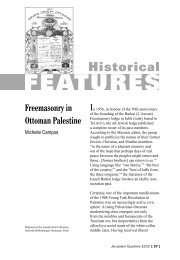
![In Search of Jerusalem Airport [pdf] - Jerusalem Quarterly](https://img.yumpu.com/49007736/1/180x260/in-search-of-jerusalem-airport-pdf-jerusalem-quarterly.jpg?quality=85)
